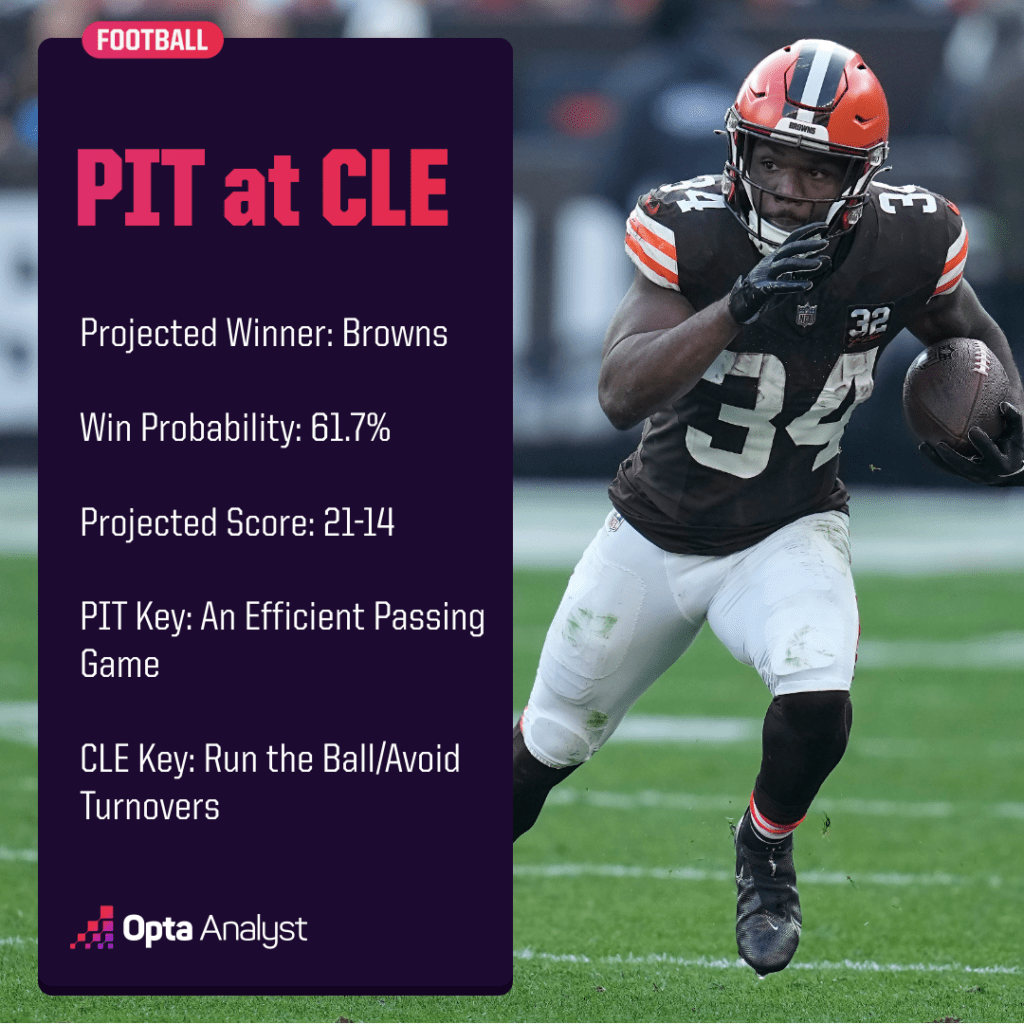The Cleveland Browns knew they’d have Deshaun Watson for only six games last season. That surely wasn’t the plan in 2023.
That’s the tough reality facing one of the NFL’s most hard-luck franchises as it prepares to face the longtime rival Pittsburgh Steelers this Sunday in a crucial mid-November clash at Cleveland Browns Stadium in Ohio that will very likely have a big say in how things will ultimately play out in the ultra-competitive AFC North.
The Browns were on cloud nine just a weekend ago after an incredibly gritty – and important – 33-31 victory over the first-place Baltimore Ravens that further tightened the AFC North race. That rush of euphoria was followed by a sudden and massive comedown, however, when the team announced Wednesday that Watson would be undergoing season-ending surgery to repair a fractured bone in his right shoulder.
It’s a gut punch for sure to a team our season projection model still gives a slight edge to win the division, but the Browns have taken their share of body blows throughout this season and have come back swinging every time. They certainly looked down for the count in Baltimore last week before scoring 16 unanswered points in the final nine minutes to pull out a seemingly near-impossible win on the road over one of the AFC’s clear top contenders.
The Steelers have displayed plenty of resiliency of their own in building an identical 6-3 record that Cleveland carries into this contest, a mark that’s defied logic in a multitude of ways.
Pittsburgh has been outgained in every game this season with an overall total net yards differential of minus-865 that’s the third worst in the NFL, and it sits 25th or below in the league both offensively and defensively in our EVE rankings (efficiency vs. expected).
The Steelers are in rare company as one of only five teams in NFL history to win at least six of its first nine games with an overall point differential of -25 or more, and Pittsburgh is just the second to go 6-3 or better while being outgained by more than 800 total yards.
For the record, the 1992 Denver Broncos were the other. They wound up 8-8 after losing five of their last six games.
LOWEST POINT DIFFERENTIAL/TEAMS WITH 6+ WINS THROUGH 9 GAMES
- 1986 Cincinnati Bengals (Record: 6-3/Differential: -30/Result: 10-6, missed playoffs)
- 2020 Cleveland Browns (6-3/-28/11-5, lost in AFC divisional round)
- 2016 Houston Texans (6-3/-27/9-7, lost in AFC divisional round)
- 2023 Pittsburgh Steelers (6-3/-26/TBD)
- 1936 Pittsburgh Pirates (6-3/-26/6-6, missed playoffs)
So, how have the Steelers done it? For starters, their turnover margin of plus-10 is tied for the best in the NFL, and the steady leadership of veteran head coach Mike Tomlin has often shown through when it matters most as they’re a perfect 6-0 in games decided by seven points or less.
That includes a 26-22 home win over the Browns back in NFL Week 2 delivered in typical Steelers fashion, as they overcame a 408-255 deficit in total yards by forcing four turnovers and scoring a pair of difference-making defensive touchdowns.
Another nail-biter could be in store this week, as the sportsbooks have Cleveland as a tepid 1.0-point favorite with the present over/under total an unusually low 33 points. Our predictive model also indicates a low-scoring affair is the best bet for this one, though the supercomputer doesn’t share the betting public’s concerns of the Browns starting raw rookie Dorian Thompson-Robinson at quarterback in Watson’s steed.

PIT Key: An Efficient Passing Game
There’s little question that the Steelers’ preferred offensive game plan would be a run-centric one focused on their quality backfield tandem of Jaylen Warren and Najee Harris, and their chances of winning would likely increase substantially if they’re able to run the ball as well as they have the past two weeks.
Warren and Harris combined for 157 rushing yards in Pittsburgh’s Week 9 victory over the Tennessee Titans, and the Steelers churned out a season-high 205 yards on the ground in last Sunday’s 23-19 triumph over the Green Bay Packers.
Approaching that level of productivity would likely prove difficult against the Browns, however. Cleveland has allowed a league-low 26.9% of successful run plays by its opponents, and its stuff rate (tackles of rushers for negative yards) of 14.4% is the highest of any defense. The Steelers’ run game couldn’t get anything going in the win over Myles Garrett and Cleveland, managing a mere 55 yards on 21 attempts.
Pittsburgh certainly isn’t going to sling it up and down the field either, as it’s the only team yet to have a game of 250 or more net passing yards this season. The Steelers have made some modest strides in that area, though, since top receiver Dionte Johnson returned from a hamstring injury in Week 7.
The combined open rate of Pittsburgh receivers during Johnson’s absence from Weeks 2-5 was a lousy 62.5%, the lowest in the NFL during that time frame and a significant contributor to quarterback Kenny Pickett’s subpar 56.6% completion rate over that stretch. In the four games since Johnson’s been back, the Steelers’ open percentage has risen to an above-average 82.6 and Pickett has connected on nearly 64% of his attempts.
Johnson hasn’t been a miracle worker, however, as Pickett’s improved completion percentage has been inflated by an escalation in dump passes to Harris and Warren and Pittsburgh’s best downfield threat, George Pickens, has seen his numbers decline since Week 7 despite both his open and burn percentages increasing since Johnson returned.
Pickett has performed very well in one important aspect, as he’s consistently taken care of the ball with five straight games without an interception and a current streak of 147 consecutive attempts without a pick. That’s a big deal for a Pittsburgh team that’s thrived on winning the turnover battle all season long, and should have a very reasonable chance of doing so again this week considering the Browns’ propensity for giveaways which we’ll get more into later.
Pittsburgh’s offense still faces some pretty steep challenges this week. For one, Johnson and Pickens are primarily outside receivers and the Browns possess arguably the premier outer coverage duo in Denzel Ward and Martin Emerson, both of whom rank among the league’s best in preventing open space.
LOWEST OPEN-ALLOWED% BY CBs LINED UP OUTSIDE (MIN. 30 DEF. TARGETS)
- James Bradberry, Philadelphia Eagles (53.8)
- DaRon Bland, Dallas Cowboys (56.3)
- Denzel Ward, Cleveland Browns (56.4)
- Emmanuel Forbes, Washington Commanders (56.8)
- Martin Emerson, Cleveland Browns (57.9)
Ward has also yielded the lowest burn rate among corners lined up outside at a minuscule 28.2% and Cleveland’s stout pass rush presents another potential problem as well. The Browns rank fourth overall in pressure rate at 40.1%, while the Steelers have allowed the fourth-highest rate of pressures at 42.4%.
With those unfavorable matchups in place and their overall limitations on offense, expect the Steelers to employ another vanilla approach designed to minimize mistakes and get just enough output to be in a position to win, provided the defense does its part.
And that’s a blueprint that just might work, given the Browns’ own issues on offense.
CLE Key: Run the Ball/Avoid Turnovers
Watson’s unavailability makes the Browns’ intentions quite transparent. They’ll try to hide the inexperienced Thompson-Robinson as much as possible while leaning on their persistent running game and sturdy defense. I
t’s the exact formula that proved fruitful back in Week 6, when Cleveland rushed for 160 yards and made life miserable for San Francisco quarterback Brock Purdy to come away with a stunning 19-17 victory over the then-unbeaten 49ers with P.J. Walker subbing for an injured Watson.
The Browns have been able to sustain a viable ground attack despite losing star back Nick Chubb to a torn ACL in their previous meeting with the Steelers. Their average of 151.2 rushing yards per game since Week 6 is second only to the Ravens for the most in the NFL during that period, and second-year pro Jerome Ford has shown to be a viable – albeit inconsistent – lead-back option in Chubb’s place.
Ford has some boom-or-bust to his game. He’s been stuffed at the highest percentage of any running back with 60 or more carries this season, but his yards after contact (2.19) and missed/broken tackles per touch (0.166) averages are both above the league norms, and he played a key role in last week’s upset over Baltimore with a career-high 107 yards on 17 rushes.
The Browns will almost certainly need another big effort out of Ford, who is a far more elusive alternative than plodding teammate Kareem Hunt. Thompson-Robinson’s forced start against Baltimore in Week 4 was a three-interception disaster that resulted in a 28-3 loss, plus Cleveland may be facing the daunting prospect of having to combat T.J. Watt and a formidable Pittsburgh pass rush without injured tackles Jedrick Wills and Dawand Jones.
Both Watt and running mate Alex Highsmith made their presence felt in a big way in Pittsburgh’s Week 2 win over Cleveland in which the Steelers sacked Watson six times and forced four pivotal turnovers. Highsmith had a Pick-6 of Watson on the game’s first play, then later registered a strip-sack that Watt ran in for the go-ahead touchdown in the fourth quarter.
HIGHEST TEAM PRESSURE RATES THROUGH WEEK 10
- New York Jets (40.7)
- Buffalo Bills (40.3)
- Pittsburgh Steelers (40.2)
- Cleveland Browns (40.1)
- Baltimore Ravens (40.0)
Cleveland’s 19 giveaways are the most in the NFL and a major concern going into a matchup with a Pittsburgh defense that’s tied for the league lead with 2.0 takeaways per game, especially with a rookie quarterback who seriously struggled when under duress and when attempting downfield throws in his lone other start.
Thompson-Robinson completed just 3-of-11 passes with a well-thrown rate of 54.5% and a pickable pass percentage of 18.2 when pressured by Baltimore, and he was 2 of 13 with two picks on throws of 11 or more air yards.
Thompson-Robinson did have somewhat of an excuse for that performance, as he wasn’t declared the starter until Watson was scratched shortly before kickoff and was put into a nearly impossible situation of taking on a top-tier defense with little to no preparation time. Still, the Browns would surely prefer to take as much burden off the 24-year-old QB as it can by establishing the run.
Cleveland did put up 198 rushing yards in these teams’ first meeting even with Chubb out for most of that game. And although the Steelers have been better against the run since being gashed for a combined 386 yards over the first two weeks, they still rank largely in the middle of the pack in just about all standard and advanced rushing defense categories.
That Week 2 game showed that running the ball effectively won’t guarantee the Browns success, though it very well could if they’re able to avoid the mistakes that have plagued them at times throughout the season.
Check out our MLB offseason analysis and NBA season coverage, and our NFL picks and college football predictions. Follow us on X and Instagram for more!
